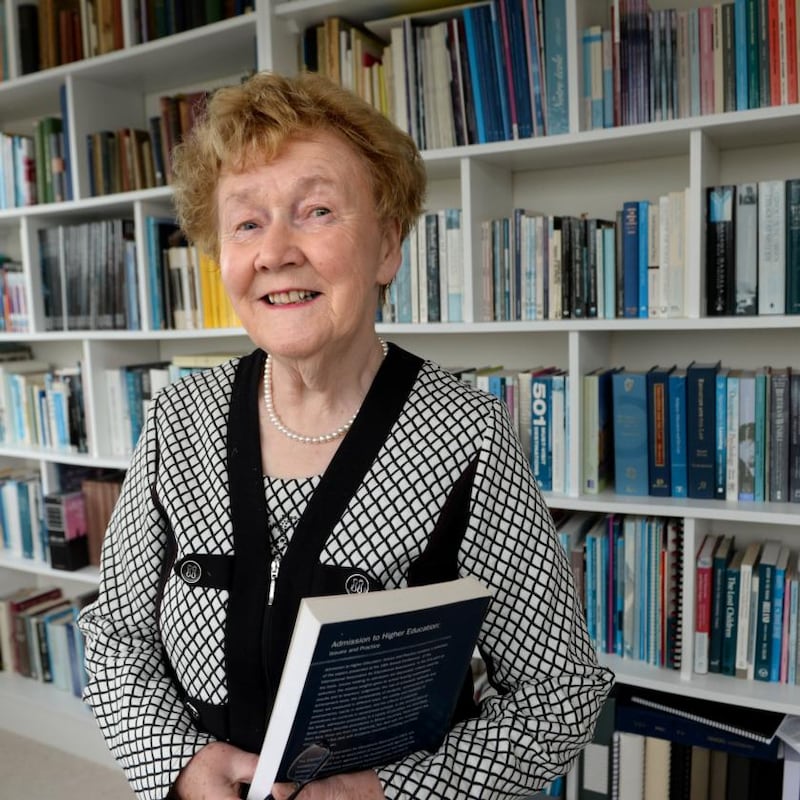It was the day everything changed: March 12th, 2020. Schools and colleges were shut and catapulted into an experiment in remote learning on a massive scale. Students and teachers grappled overnight with online learning. Exams were deferred, cancelled or replaced by untested systems. Homeschooling triggered tantrums and tears – and that was just the parents.
In many ways, the education system showed its resilience amid the chaos. Technology helped learning continue remotely. New assessment methods led to predicted Leaving Cert grades, which allowed students move on with their lives. Infection control measures adopted by schools helped classrooms reopen and remain relatively safe settings.
But in other ways the pandemic shone a light on a creaking education system, which is struggling to do the job required of it. The most vulnerable – such as children from poorer backgrounds – experienced the steepest learning losses of all. The loss of structure and routine was catastrophic for those with special needs. The virus threat was also a jolting reminder of an overcrowded, underfunded education system rooted in a 20th century model of learning.

As a new academic year gets under way, our education system is at an uncertain crossroads: do we go back to the status quo?
Or do we create a new system that embraces all we’ve learned and which gives young people the best possible start in life?
Money, of course, is key. This year the education budget climbed to a record high of almost €9 billion with additional funds for new teachers, smaller class sizes at primary level and supports to keep schools safe.
However, the system is still being run on a relative shoestring compared with many other top-performing countries.
Latest figures from the Organisation for Economic Co-operation and Development (OECD) show investment in education in the State as a percentage of national wealth languishes at the bottom end of the league table for wealthy countries. Even if the impact of multinationals on GDP distorts our performance, the reality is many schools spend much of their time fundraising and seeking “voluntary contributions” to help make ends meet. Irish primary schools are saddled with some of the largest class sizes in the developed world. The gap in outcomes for pupils between poorer and affluent areas remains stark. The question of how to fund a third-level system that is set to grow dramatically over the coming years remains unresolved.
"Without significantly increasing funding for the education sector, any debate around its future will prove to be little more than a talking shop," says Michael Gillespie, Teachers' Union of Ireland general secretary.
“Now, more than ever, education spending must be seen as essential investment in Ireland’s future. The dividends of prioritising education in such a way would drive significant positive change for the individual, for our communities and for our economy.”
One lesson that the pandemic taught us is the limits of one-size-fits-all schooling. Some students actually liked not being in school, as the lack of social pressure allowed them to focus on learning. Some were lonely at home and couldn’t wait for school to reopen.
In reopening schools, can we do so in a way that creates different kinds of opportunities for all kinds of learners: introverts and extroverts, fast processors and reflective thinkers?
Andreas Schleicher, the director of education and skills at the OECD says this is something to think about given that the Irish education system is "very much 20th century" in its infrastructure and architecture.
“Students get taught one curriculum. It’s quite heavily focused on the reproduction of subject matter, and not that much focused on getting students to think out of the box, link across the boundaries of subject matter disciplines. That is something to think about,” he told The Irish Times earlier this year.
If we don’t reform, he says, the danger is that we end up educating “second-class robots” and try to “push everybody through the same pipeline” rather than providing a range of different vocational and academic pathways for students.
He cites countries such as Switzerland as the "poster child" for top-performing countries where many of the brightest students choose vocational options, while he says Singapore and Slovenia are creative systems which focus on a broad range of outcomes rather than just narrow academic learning.
Schools that dipped their toes in remote and digital learning before the pandemic had no choice but to dive in head-first when Covid-19 arrived.
Donncha Ó Treasaigh, director of schools at Limerick and Clare Education and Training Board, saw a huge change in how schools responded between the first and the second lockdown.
“Schools were much better prepared the second time around,” he says. “Teachers were upskilled, there was greater access to devices . Everyone was better informed around workflows and assessments online.”
Prior to the pandemic, a criticism over the move to digital devices was that it often involved transferring traditional teaching practices online rather than harnessing the potential of technology. Students, for example, were sometimes learning from photos of textbooks on their devices.
Ó Treasaigh, however, says most schools and teachers have since moved on and are tailoring assessments for students and providing one-to-one feedback. Schools where the rollout of technology is successful, he says, involve careful planning, training and engagement with students, parents and teachers.
“One of the big challenges is to ensure we use technology to ensure students are content creators and effective collaborators online, as opposed to being consumers of YouTube videos,” he says .
The pandemic prompted the unthinkable: a system of grades based on teachers' predictions, along with a standardisation process
Devices and digital technology, he says, will play an ever greater role in education over the coming years as learning platforms and resources improve. They could allow schools to share specialist teachers and expand students’ access to minority subjects; allow all-Irish schools to tackle teacher shortages by sharing resources.
“The reality is we’re living in a society that has changed forever in terms of how we work, conduct meetings and teach, so it’s vital that our children have the skillset to manage this technology,” Ó Treasaigh says.
For decades there’s been talk of reforming the Leaving Cert, which most agree is too narrow, inflexible and doesn’t capture the wide range of students’ intelligence. Yet, despite various reform plans, we’ve stuck with it because we’re culturally obsessed by the exams and public trust in them is relatively high.
Until last year. The pandemic prompted the unthinkable: a system of grades based on teachers’ predictions, along with a standardisation process. This year, students were once again able to avail of this option along with sitting the written exams.
The experiment has been a success in many ways, even if some individual students felt hard done by. It eased student anxiety, won public support and helped even out the playing field for students from poorer backgrounds.
The official line from the Department of Education is that the State exams will take place again in as normal a manner as possible next year. Among civil servants and teaching unions there is little appetite for a rerun of accredited grades based on teachers’ estimates. But the genie is out of the bottle. Students want more change. The Irish Second-Level Students’ Union is overwhelmingly in favour of giving students more choice.
The State’s advisory body on the curriculum is also due to issue an advisory report on reform plans such as broadening assessment over a longer period and emphasising work experience and access to vocational options that could count towards CAO points.
How much did the pandemic affect students? The latest research is out and the answer is clear: significantly. Most students experienced learning loss, but vulnerable pupils – those from disadvantaged background and with special needs - were hit hardest.
Most experts point to the need for catch-up education and support to help bridge these gaps. While a summer programme was a start, many point to the need for a more fundamental shift to ensure we meet the needs of all learners.
Adam Harris, chief executive of autism charity AsIAm, says major changes are needed to ensure the rights of children with disabilities are protected. "The reality is that many of these children in our education system are invisible," he says. "Whether they are without a school place, on reduced timetables, have been unfairly suspended or expelled, or have simply fallen out of the system, there's no data on them. Where there's no data, there's no accountability... the system is built on a grace-and-favour approach, and this does not meet either the spirit of our constitution or our international obligations ."
A key change needed, he says, is the commencement of rights-based legislation that guarantees access to education and health services for vulnerable children, along with wider cultural changes that put the needs of the child front and centre.
Tanya Ward, chief executive of the Children's Rights Alliance, also says we need a radical overhaul of our education system to ensure there are alternative options for children who have disengaged from mainstream education and greater investment in schools that serve children from disadvantaged areas. A failure to do, she says, means too many children will be denied their right to an education.
******
'A failure to reform the Leaving Cert would be failure of imagination – and justice '
Anne Looney
Professor and Executive Dean at DCU Institute of Education

Across education systems end-of-school examinations such as Ireland’s Leaving Certificate have been disrupted, cancelled and modified in the last couple of years. And all these systems face the choice now faced in Ireland: to reset or move forward.
Facing this choice, many systems are also finding that there is a new powerful stakeholder in education policy deliberations as school students find their voices. In their survey of 20,000 students in January 2021, just 4 per cent of students wanted to “reset” back to the Leaving Certificate this year.
Despite their discomfort, Teachers highlighted the limitations of traditional examinations ... and that the playing field of examinations is far from level
Based on early evidence from research by colleagues in DCU and in Maynooth University, the proportion of teachers who want to "reset" is going to be considerably higher.
They found the accredited grades processes challenging and stressful, not because of the amount of work involved, but because it cast them in the role of “judge and jury” with potentially high-stakes consequences.
The early signs from the Department of Education is that the direction of travel in Ireland will be backwards. A recent announcement flagged that the Leaving Certificate examinations in 2022 will be adjusted to give additional choice and will “play to student strengths by leaving intact the familiar overall structure of the examinations”.
But there is no evidence that the familiar structure is aligned to student strengths. Extended written work in controlled conditions is a strength for some. But certainly not for others.
Amid the many challenges that came from trying to reconstruct the Leaving Certificate in a pandemic, we had a glimpse of a Leaving Certificate 2.0. Extended opportunities to achieve in different formats. And at different times. Written exams as part of the assessment process, but not under pressure cooker conditions. The professionals most familiar with the students and their work playing a key role, but not as ultimate arbiter. Because despite their discomfort, what teachers achieved was to highlight the limitations of traditional examinations; for some students, especially those from lower-socio-economic backgrounds, the playing field of examinations is far from level.
That we would ignore what was achieved and contemplate sending teams out to play on that same surface from 2022 and beyond is not just a failure of imagination. It is a failure of justice.
'Our key lesson is that schools must never be closed again'
Áine Hyland
Emeritus professor of education, UCC

The closure of schools during the pandemic impacted disproportionately on children and young people from less advantaged backgrounds and those with additional educational needs.
The negative impact was evident in children’s academic attainment and in their mental health. Whereas all children lost at least four months of academic attainment, the loss for children from disadvantaged backgrounds was up to 60 per cent greater. Those particularly affected were children whose parents had limited education, Travellers, families in direct provision, the homeless, single parents and those in crowded accommodation.
'There is a craving for the kind of social and intellectual interaction that comes from physically being present in a place, and from interacting with your peers'
Schools are not just seats of learning – for many children they provide security, a structure to the day and a caring environment. In Deis – or disadvantaged – schools they provide breakfast clubs, lunch and after-school care and activities. Homeschool community liaison teachers and school completion staff provide an important link between school and home and are often the first to draw attention to child neglect or abuse. The sudden withdrawal of all these supports during school closures had a devastating effect on many families.
School closures also had a profoundly negative effect on children and young people with special educational needs and their families. For them, schools are the centre, not just of learning, but also of a range of caring and other supports and therapies. For them school closures were a disaster.
The key lesson learned for education from the pandemic is that schools must never be closed again. Moreover, the supports available for children in Deis schools must be extended to children from disadvantaged backgrounds attending non-Deis schools. Teachers are the human face of education – they are essential workers and their commitment and expertise must be recognised and rewarded. Homeschooling – even with an enhanced online learning infrastructure – will never replace teachers, especially for the less advantaged and those with additional educational needs.
'The future of education will be about who is included and excluded'
Linda Doyle
Provost, Trinity College Dublin

For me, the importance of space and place in education has been reinforced. There is a craving for the kind of social and intellectual interaction that comes from physically being present in a place, and from interacting with your peers. In the last few weeks we had our first in-person graduations in 18 months. No amount of honouring our students online came close to comparing with the real celebration of marking the end of their passage through university and commencement of the next phase of their lives.
If this matters at the end of the degree, it matters even more throughout. The early predictions, at the beginning of the pandemic, of the demise of many educational institutions and the rise of the few large brands online, were premature. The relationship with the place you study, and those who share that place with you, matters and will continue to matter.
In parallel with this, of course, is the undeniable fact that online education has brought an equality and level of access for some students for whom, in pre-pandemic times, it was not a possibility. This has particularly been the case for those with physical disabilities or those with responsibilities which keep them from travelling to a place of education. Zoom and Teams in that sense have been levellers. But online education too has reinforced space and place in a different way. The right place and space can be about having a quiet place to go online. It can be about access to the right broadband. It can be about your place and role in the home, and how that role impacts on the space you have to engage in education.
So, what I have learned overall is that space and place matters in the physical and digital worlds, and that the future of education, no matter what form it takes, will always be about who is included and excluded from spaces and places. And that we will do best when we ensure that our physical and digital worlds include as many as possible of those students who share our passion to learn.


















